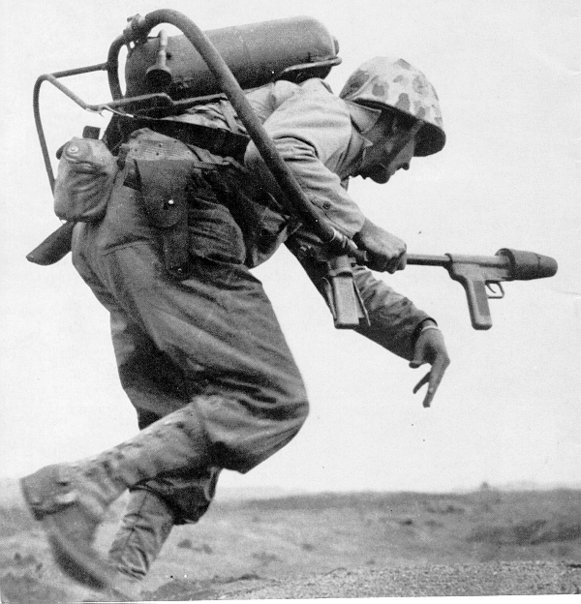
The life expectancy of a Marine flame thrower, on Iwo Jima was measured in minutes -30.
Iwo Jima -65 Years Ago Today -Part II
February 17, 2010
February 17, 1945
One of the most controversial elements of the Iwo Jima invasion was the extent of the pre-landing bombardment. Marine commanders, whose previous experience had made them painfully aware that considerable time was necessary to find and destroy often-well-hidden Japanese defensive positions, had requested ten days of preliminary shelling. Fifth Fleet commander Admiral Raymond A. Spruance, who had overall responsibility for the operation, knew that time and ammunition supply did not permit such a long bombardment, and also believed, incorrectly, that months of constant attacks by long-range bombers had degraded enemy defenses. He accordingly allowed only three days for the task, and stuck to that allotment despite the Marines' pleas for more.
When Rear Admiral William H.P. Blandy's Task Force 54 arrived off Iwo Jima on 16 February 1945, ready to begin shelling, rain and low visibility made effective gunfire control nearly impossible. Though six battleships (Arkansas, New York, Texas, Nevada, Idaho and Tennessee), five cruisers (Pensacola, Salt Lake City, Chester, Tuscaloosa and Vicksburg) and many destroyers were present and shooting, at the end of the 17th results were modest, at best.
Task Force 54 included Idaho and Tennessee, freshly
returned from overhaul at West Coast navy yards; Nevada, Texas and Arkansas,
veterans of Operations OVERLORD and DRAGOON, and 30-year-old New York,
taking part in an amphibious operation for the first time since TORCH in
1942.
Heavy cruisers Chester, Pensacola, Salt Lake City
and Tuscaloosa (also a European veteran) and the new light cruiser Vicksburg,
with assigned destroyers, completed the gunfire support force.
Admiral Spruance's flagship Indianapolis, together
with battleships North Carolina and Washington, would join on February
19, D-day.
The Battle for Iwo Jima would mark a departure in the
strict government censor of news from the war. Prior to this battle the
government would carefully monitor and stem the flow of news, photos and
print from a battlefield. Everything that would be objectionable or could
possible cause a moral problem (high death tolls, friendly fire, gruesome
photographs, etc..) were banned. There was a week to fourteen days lag
in the news.
But in 1945 there was a growing weariness in the war
by many Americans. People began to question the great sacrifice of lives.
Why didn't we just bomb Japan into surrender? Why did we have to island
hop?
Roosevelt decided to allow cameras and press to accompany
the Marines onto Iwo Jima and report the war directly to the American people.
This action will come into play later with respect to the flag raising
photo.
Bombardment ships were in position off Iwo by 0700 on the 17th of February.. Minesweeping began promptly and at 0803 the heavy vessels were ordered to close the beaches for destructive bombardment. Pensacola observed the sweepers being fired on, laid her secondary battery on the firing positions and silenced them within five minutes. But coastal batteries in the northeastern part of Iwo had their revenge. Pensacola around 0935 received six hits from 4.7- or 6-inch shells that wrecked her C.I.C., set fire to a plane on her starboard catapult, punctured her hull on the starboard side forward, killed 17 men and wounded 98. She withdrew temporarily to fight fires and treat casualties, but later returned to station and concluded her mission.
By 0911 Idaho, Nevada and Tennessee were 3000 yards off the beaches sending heavy direct fire at assigned targets. At 1025 Admiral Blandy ordered them to retire in order to clear the UDT operations, set for 1100. By that time the minesweepers were clear, having swept up to 750 yards of the shore in precise formation, banging away with their own weapons and occasionally coming under fire from the island.
American air forces pounded Iwo in the longest sustained aerial offensive of the war.
"No other island received as much preliminary pounding as did Iwo Jima." --Admiral Nimitz, CINPAC
Incredibly, this ferocious bombardment had little effect. Hardly any of the Japanese underground fortresses were touched.
Twenty-one thousand defenders of Japanese soil, burrowed in the volcanic rock of Iwo Jima, anxiously awaited the American invaders.
The US sent more Marines to Iwo Jima than to any other battle, 110,000 Marines in 880 Ships. The convoy of 880 US Ships sailed from Hawaii to Iwo in 40 days.
It was the largest armada invasion up to that time in the Pacific War.
It would be just 48 hours before Americans would find
out about Iwo Jima.
In just two days a small column would appear on the
front pages of newspapers: "Marines land on Iwo"
This is how Mansfield began to learn of the Battle of Iwo Jima and the participation of five of her sons: Al Fercozo, George Santucci, Frank Green, Guido Amici, and Guido (Guy) Liberatore.
What was thought to be an easy victory turned out to
be one of the bloodiest battles of the war.
The black volcanic sands of Iwo Jima claimed close
to 30% of all our Marine losses in the war.
The one month battle for Iwo Jima left 6,821 Marines
dead and 20,000 wounded.
Twenty-seven Congressional Medals of Honor were awarded
in the Battle - more than were awarded to Marines and Navy in any other
Battle in our country's history.
But as the first day of shelling came to a close, on
board Admiral Turner's flagship, the press briefing was uncommonly somber.
General Holland Smith predicted heavy casualties,
possibly as many as 15,000, which shocked all hands.
A man clad in khakis without rank insignia then stood
up to address the room.
It was James V. Forrestal, Secretary of the Navy.
"Iwo Jima, like Tarawa, leaves very little choice," he said quietly, "except
to take it by force of arms, by character and courage."

The life expectancy of a Marine flame thrower, on Iwo Jima was measured in minutes -30.